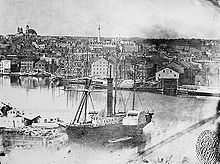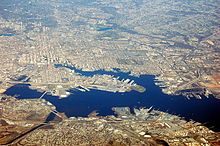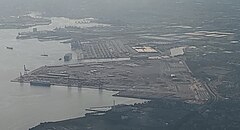| Port of Baltimore | |
|---|---|
 Cargo loading cranes at the Sea Girt and Dundalk Marine Terminals along the northeast shore of the Northwest Branch of the Patapsco River towards the Inner Harbor and downtown Baltimore | |
 Click on the map for a fullscreen view | |
| Details | |
| Owned by | Maryland Port Administration |
| Draft depth | 50 feet |
| Air draft | 182 feet (Chesapeake Bay Bridge). Previously also restricted to 185 feet by the Francis Scott Key Bridge (1977-2024) |

The Helen Delich Bentley Port of Baltimore is a shipping port along the tidal basins of the three branches of the Patapsco River in Baltimore, Maryland, on the upper northwest shore of the Chesapeake Bay. It is the nation's largest port facility for specialized cargo (roll-on/roll-off ships) and passenger facilities. It is operated by the Maryland Port Administration (MPA),[1] a unit of the Maryland Department of Transportation.[2]
Founded in 1706, the port was renamed in 2006 for Helen Delich Bentley (1923–2016), who represented Baltimore as a U.S. Representative for a decade and who had also been a maritime reporter and editor for The Baltimore Sun daily newspaper.[3]
On March 26, 2024, the collapse of the Francis Scott Key Bridge blocked ships' access to the port; the channel was fully reopened on June 10, 2024.
History
[edit]In 1608, Captain John Smith traveled 170 miles (270 km) from Jamestown (established the previous year) exploring the shores, rivers, creeks, and streams to the upper Chesapeake Bay towards the Susquehanna River, leading the first European expedition to the Patapsco River, named after the native Algonquian peoples who fished shellfish and hunted.[4][5]
English royal and proprietary land grants from 1661 were combined in 1702 by James Carroll, who named it Whetstone Point because of the landform shape resembling a sharpening stone. The area is now known as Locust Point, a residential and industrial area. The port was founded on this site in 1706 by the provincial Maryland General Assembly, which designated it one of the official Port of Entry for the tobacco trade with the Kingdom of England. In 1729–1730, Baltimore was established by Act of Assembly to the northwest at "The Basin" of the Northwest Branch of the Patapsco. This area was later known as the Inner Harbor.
In 1776, local citizenry erected earthworks for port defense during the American Revolutionary War known as Fort Whetstone. These port fortifications were replaced beginning in 1798. In addition, Fort McHenry was expanded and reconstructed with brick and stone in a "star fort" shape. This work was conducted by the officers and engineers of the United States Army and its Corps of Engineers and the U.S. Department of War.[6]

Fells Point, first named Long Island Point in 1670, is the deepest point in the natural harbor on the north shore of the Northwest Branch of the Patapsco. It soon became the colony's main shipbuilding center, with many shipyards, famed for the construction of the unique styled Baltimore clipper smaller-sized sailing schooners. These were notorious as commerce raiders, and privateers used them. This type of activity led to the British attack in September 1814, during the War of 1812 known as the Battle of Baltimore. It is noted for the famous bombardment of Fort McHenry as well as a land attack to the southeast at the Battle of North Point, which attacked fortifications on the east side of town at Loudenschlager's and Potter's Hills (today's Hampstead Hill/Patterson Park). Fells Point was incorporated into old Baltimore Town in 1773. The Continental Navy ordered their first frigate warship, USS Virginia, from George Wells at Fells Point in 1775. The first ship named the U.S.F Constellation was produced at the Harris Creek shipyard east of Fells Point (the site of the future neighborhood of Canton) by a master shipwright from Hingham, Massachusetts named David Stodder.[7] The third USS Enterprise was built at Henry Spencer's shipyard. Over 800 ships were commissioned from Fells Point shipyards from 1784 to 1821. The California Gold Rush of 1848–1849 led to many orders for fast vessels. Many overland pioneers also relied upon canned goods supplied from Baltimore factories.[8][9]

After Baltimore's founding, the waterfront developed into drydocks, warehouses, ship chandlers, and industry, including mills, which were built behind the wharves. In what is now Canton, further southeast of Baltimore and Fells Point along the Patapsco River, John O'Donnell's plantation was developed in the early 1800s for worker housing and industry, including the Canton Iron Works owned by Peter Cooper and later Horace Abbott during the Civil War and others.[10]
In 1828, the Baltimore and Ohio Railroad (B&O) began track laying, eventually extending into Locust Point in 1845. The arrival of B&O and other railroads made the port a central transshipment point between inland points and the rest of the world.[11] By the 1840s, the Baltimore Steam Packet Company ("Old Bay Line") was providing overnight steamship service down the Chesapeake Bay.[12] After the Civil War, coffee ships were designed here for trade with Brazil. Other industrial activities in Canton included Baltimore Copper Smelting Company and small oil refineries, later purchased by Standard Oil.[13] By the end of the nineteenth century, European ship lines had terminals for emigrants from Britain, Ireland, Germany, and Poland.[11]
Harbor channels and approaches
[edit]Maintenance of harbor channels and navigation aids began early. Dredging in the harbor can be traced back as far as 1783, when the Ellicott brothers (of Ellicott Dredges) excavated the bottom at their wharf in the Inner Harbor. In 1790, the state government began systematic dredging using a "mud machine", which used a horse-drawn drag bucket, later upgraded with steam power. In 1825, Sen. Sam Smith of Maryland petitioned Congress for federal funding for this work.[14]


At this time, Congress was smarting from the incursions of the War of 1812 and had determined to expand naval defenses. In Baltimore, it led to the misconceived construction of Fort Carroll, an island three-tiered brick fortification in the 1840s (similar to various other East Coast island forts built such as the famous Fort Sumter in Charleston harbor, South Carolina), supervised by young Col. Robert E. Lee of the United States Army Corps of Engineers but federal dredging appropriations preceded that project, beginning in 1830. This first project was completed in 1838. In the 1850s, a second dredging project was undertaken under Capt. Henry Brewerton, who was also later in charge of the Fort Carroll project. He excavated a straight channel from Sparrows Point out to the mouth of the Patapsco near Seven Foot Knoll Light between North Point and Hawkins Point, which was erected in 1855; this channel, known today as the Brewerton Channel, continues to be the central link in the path into the harbor.[citation needed]
In 1865, Maj. William Price Craighill took over as Baltimore District Engineer of the Corps of Engineers. His initial survey of the Brewerton Channel disclosed severe shoaling at the mouth of the river. He excavated a new channel starting from the older channel at a point just northwest of Seven Foot Knoll and running south to the mouth of the Magothy River, where it turned to the south-southeast and continued to Sandy Point, just north of the present location of the Chesapeake Bay Bridge. In the 1870s, a cutoff channel was dug to ameliorate the turn between the old and new channels; the Brewerton Channel was also extended to provide a connection to the Chesapeake and Delaware Canal. Enlarged and extended to access various facilities within the port, the Brewerton and Craighill Channels continue to be used to the present, essentially unaltered in configuration.[15]
Federal lighthouse construction in the bay began in the 1820s, and one early project was the erecting of range lights to guide ships into the Patapsco. The North Point Range Lights were lit in 1822, marking a path roughly the same as that of the current Craighill Cutoff Channel. Subsequent channel construction was followed shortly by light projects. Brewerton's channel was marked by the Hawkins Point and Leading Point lights, constructed in 1868 and converted to skeleton towers in 1924. The original (lower) Craighill Channel was marked with range lights in 1875, following two years of temporary lightships; the cutoff was marked with the upper range lights in 1886, replacing the North Point range, which had been discontinued in 1873. In later years, a pair of skeleton towers were erected on Locust Point to mark the Fort McHenry Channel, the final leg from the end of the Brewerton Channel to Curtis Point and the Inner Harbor. These lights remain in use, though they have all been automated. The Craighill Channel Lower Range Rear Light enjoys the distinction of being the tallest lighthouse in Maryland.[citation needed]
In 2006, then-Maryland Governor Bob Ehrlich participated in naming the port after Helen Delich Bentley during the 300th anniversary of the port.[3]
Current operations
[edit]Currently, the port has major ro-ro (roll-on roll-off) facilities and bulk facilities, especially steel handling.[1] The port handles around 700,000 vehicles annually.[16] Most Mercedes-Benz cars that are imported into the U.S were handled here as well in 2004.[17]
In 2019, the port handled 43.6 million short tons (38.9 million long tons; 39.6 million metric tons) in foreign commerce (imports and exports), valued at $58.4 billion. The Port of Baltimore ranked 11th of 36 US ports in handling foreign tonnage and 9th in dollar value of the cargo handled during 2019.[18]
During the third quarter of 2017, the Port of Baltimore experienced a 15% increase in general cargo tons from the third quarter of 2016. Since 2014, the Port has become the fourth fastest-growing port in North America, with a 9.8% increase in cargo handled from the previous year. It is currently ranked 8th of 36 US ports for gross tonnage and 7th in dollar value.[19][20]
The Port handles one-fourth of the country's coal exports.[21]
On March 26, 2024, the container ship MV Dali left the Port, then collided with the Francis Scott Key Bridge, which collapsed, completely blocking maritime access to the port.[22] Salvage crews worked for 11 weeks to remove the Dali and the bridge wreckage, and on June 10, 2024, the channel was fully reopened.[23][24]
Facilities
[edit]
The Port of Baltimore includes five terminal areas, which are located in the Maritime Industrial Zoning Overlay District:[25]
- Dundalk Marine Terminal. This facility handles containers, break-bulk, wood pulp, Ro/Ro, autos, project cargo, and farm and construction equipment on 13 berths. The draft is 34 ft. (10.4 m) at four berths, 42 ft. (12.8 m) at seven berths, and 50 ft. (13.7 m) at two berths. The 570-acre (231 ha) facility features 790,000-square-foot (73,393 m2) of inside storage in 10 sheds and 61-acre (25 ha) of open container storage, 20.1-acre (8 ha) of open break-bulk storage, 225-acre (91 ha) of open automobile storage; and 93-acre (38 ha) of open Ro/Ro storage.[26]
- Seagirt Marine Terminal. This facility handles containers on four berths. Draft is 45 ft. (13.7 m) at three berths and 50ft. (15.2 m) at the other berth. The 284-acre (115 ha) facility features eight super post-Panamax cranes and seven post-Panamax cranes, 22 rubber-tired gantry cranes, and has 134-acre (54 ha) of outside storage.[27]
- Fairfield Marine Automobile Terminal. This facility handles Ro/Ro and autos on two berths. Draft is 49 ft. (14.9 m) at one berth and 23 ft. (8.5 m) at the other. The facility features 61-acre (25 ha) of auto processing buildings.[28]
- North Locust Point. This facility handles wood pulp, lumber, latex, steel, paper, and containers on five finger piers with drafts of 34 ft. (10.4 m). The facility features 180,000-square-foot (16,723 m2) of inside storage and 19-acre (8 ha) of open storage.[29]
- South Locust Point. This facility handles forest products on three general cargo berths with drafts of 36 ft. (11 m). The 79-acre (32 ha) facility features 935,000-square-foot (86,864 m2) of inside storage.[30]
In popular culture
[edit]In the 1996 action film, Eraser, the film's finale and ending battle take place on and around a Russian cargo ship in the Port of Baltimore, referred to in the movie as the "Baltimore Docks".
The Port of Baltimore appeared in the 2002 thriller movie, The Sum of All Fears.
The second season of the HBO series The Wire centers around activity at the Port of Baltimore.
The first season of the Amazon Prime series Jack Ryan features the Port of Baltimore. The antagonists smuggle Cesium-137 into the port for a terror attack plot.
See also
[edit]References and notes
[edit]- ^ a b "The Port of Baltimore's Waterbourne Commerce – 2012" (PDF). Maryland Port Administration. Retrieved July 19, 2013.
- ^ "Officials Report Record Quarter For Baltimore Port". June 11, 2018.
- ^ a b Meredith Cohn (June 2, 2006). "Port 'godmother' honored". The Baltimore Sun.
- ^ Snell, Tee Loftin (1974). The wild shores: America's beginnings. Washington DC: National Geographic Society (U.S.), Special Publications Division. p. 84. ISBN 9780870441486.
- ^ "Ghosts of industrial heyday still haunt Baltimore's harbor, creeks". Chesapeake Bay Journal. Retrieved September 8, 2012.
- ^ History of Ft. McHenry, NPS; and History of the Port of Baltimore Archived May 30, 2007, at the Wayback Machine, Port of Baltimore Tricentennial Committee.
- ^ "Part 2: Warship Constellation Launched from Harris Creek, 1797". Welcome to Baltimore, Hon!. Retrieved June 24, 2018.
- ^ "Fells Point Historic district". National Park Service. Archived from the original on December 25, 2013. Retrieved July 19, 2013.
- ^ "Milestones in Fell's Point's History". Fell's Point Preservation Society. Retrieved July 19, 2013.
- ^ Canton Timeline Archived April 12, 2007, at the Wayback Machine, John Cain, Canton Community Association, 2001; and Steam in Captivity, Mary Bellis, Your Guide to Inventors, c.2007.
- ^ a b "Port of Baltimore". Maryland Manual Online. Maryland State Archives. Retrieved July 18, 2013.
- ^ "Old Bay Line". Steamboat Explorer. Archived from the original on June 13, 2010. Retrieved July 18, 2013.
- ^ "Neighborhood Overview". Canton Community Association. Archived from the original on August 26, 2013. Retrieved July 18, 2013.
- ^ Mountford, Kent (July–August 2000). "History of dredging reveals deeper need to understand Bay's bottom line". Chesapeake Bay Journal. Archived from the original on September 28, 2007. Retrieved June 22, 2007.
- ^ "Baltimore Harbor & Channels: History". United States Army Corps of Engineers Baltimore District. Archived from the original on June 25, 2007. Retrieved June 22, 2007.
- ^ Williams, Marcus (July 5, 2017). "North American ports: Slowdown after growth tests capacity to cope". Automotive Logistics. Archived from the original on August 3, 2017. Retrieved August 3, 2017.
- ^ Terry, Robert J. (March 22, 2004). "Mercedes hunts for port land". Baltimore Business Journal.
- ^ Maryland Port Administration (March 2020). "The Port of Baltimore's Waterborne Commerce Summary – 2019". 2019 Foreign Commerce Statistical Report (PDF). p. 1.
- ^ "Port of Baltimore Handling More Cargo Than Any Previous Year". November 20, 2017.
- ^ "MPA Cargo Statistics". mpa.maryland.gov.
- ^ "U.S. Energy Information Administration – EIA – Independent Statistics and Analysis". www.eia.gov. Retrieved April 12, 2023.
- ^ "Baltimore Francis Scott Key Bridge collapse: What we know about ship and bridge". BBC News. March 26, 2024. Retrieved March 26, 2024.
- ^ "Container ship removed 8 weeks after Francis Scott Key Bridge crash in Baltimore". May 20, 2024.
- ^ "Port of Baltimore ship channel reopens after Key Bridge collapse". www.bbc.com. Retrieved June 11, 2024.
- ^ "Maritime Industrial Zoning Overlay District (MIZOD) Summary & Evaluation" (PDF). Baltimore Department of Planning. 2010. Retrieved December 31, 2020.
- ^ "Dundalk Marine Terminal". Maryland Port Administration. October 16, 2020.
- ^ "Seagirt Marine Terminal". Maryland Port Administration. October 16, 2020.
- ^ "Fairfield Marine Automobile Terminal". Maryland Port Administration. October 16, 2020.
- ^ "North Locust Point". Maryland Port Administration. October 16, 2020.
- ^ "South Locust Point". Maryland Port Administration. October 16, 2020.
External links
[edit]- Maryland Port Administration - Official website
- Painting: "Yachting in Baltimore Harbor." Maryland Center for History and Culture. Retrieved March 23, 2021.
NOAA maps:
- Chapter 15 Baltimore to Head of Chesapeake Bay, Coast Pilot 3, 40th Edition, 2007, Office of Coastal Survey, NOAA.
- Baltimore Harbor
- Chesapeake Bay Approaches to Baltimore Harbor



